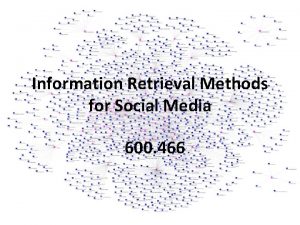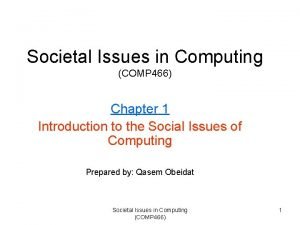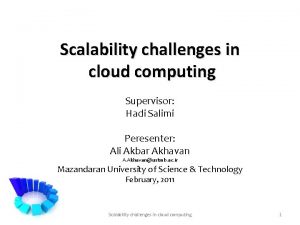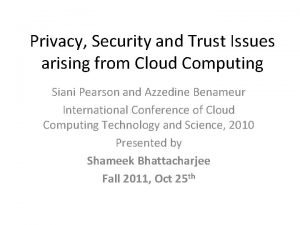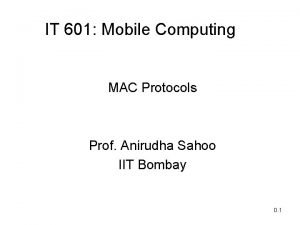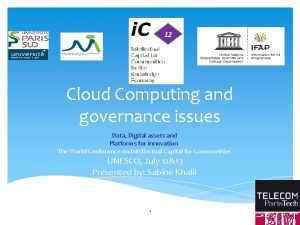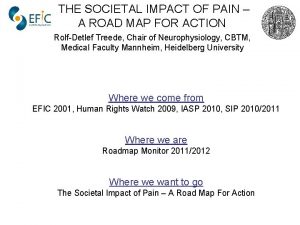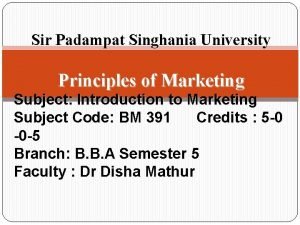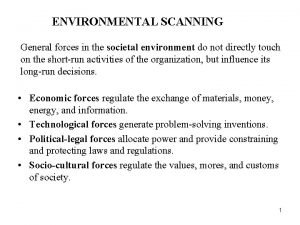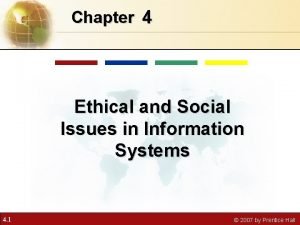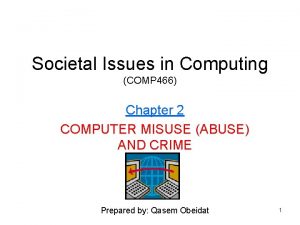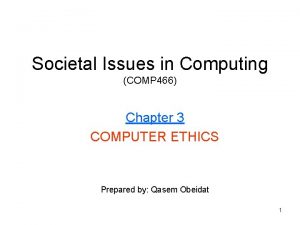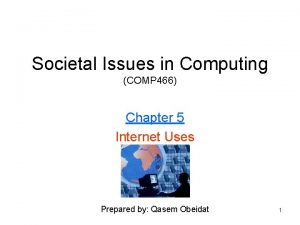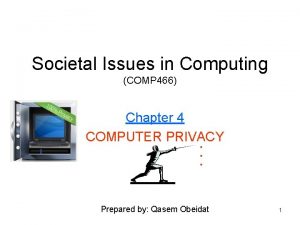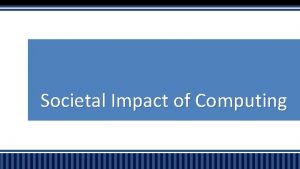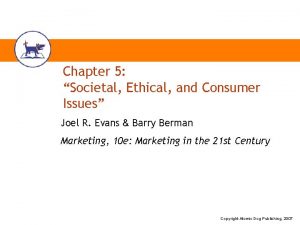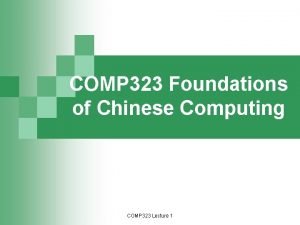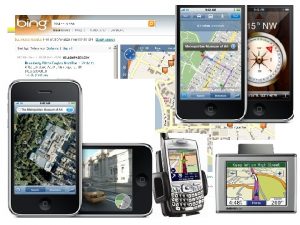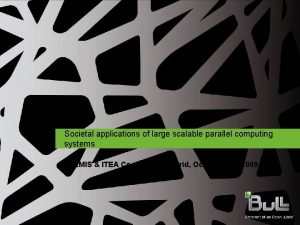Societal Issues in Computing COMP 466 Chapter 1



























































- Slides: 59

Societal Issues in Computing (COMP 466) Chapter 1 Introduction to the Social Issues of Computing Prepared by: Qasem Obeidat Societal Issues in Computing (COMP 466) 1

Social Issues • Each society establishes rules and limits • • on acceptable behaviour These rules form a moral code Sometimes the rules conflict In general they are beliefs or conventions on good and evil, good or bad conduct, justice and injustice The rules sometimes do not cover new situations Societal Issues in Computing (COMP 466) 2

Examples: • Employee monitoring. • Downloading music using Napster software at no charge. • Robert Hansen, FBI agent, convicted for providing information to Russia. • Double. Click sued for planning to reveal Web users identities. • Plagiarism. • Hackers defaced Web sites. Societal Issues in Computing (COMP 466) 3

The world is changing Societal Issues in Computing (COMP 466) 4

Rapid Pace of Change • 1940 s: The first computer is built • 1956: First hard-disk drive weighed a ton and stored five megabytes • 1991: Space shuttle had a one-megahertz computer • 2006: Pocket devices hold a terabyte (one trillion bytes) of data • 2006: Automobiles can have 100 -megahertz computers Societal Issues in Computing (COMP 466) 5

Rapid Pace of Change • Have you used a computer today? • So many people carry cell phones and i. Pods. • A day without using an appliance containing a microchip is almost as rare as a day without turning on an electric light. • When we speak of computers we include personal computers, mainframes, embedded chips that control machines, communication devices, and the Net or cyberspace. Societal Issues in Computing (COMP 466) 6

Computer History • Mechanical machines (before 1930) • • • During this period, several computing machines were invented that bear little resemblance to the modern concept of a computer. In the 17 th century, Blaise Pascal, a French mathematician and philosopher, invented Pascaline. In the late 17 th century, a German mathematician called Gottfried Leibnitz invented what is known as Leibnitz’ Wheel. The first machine that used the idea of storage and programming was the Jacquard loom, invented by Joseph-Marie Jacquard at the beginning of the 19 th century. In 1823, Charles Babbage invented the Difference Engine. Later, he invented a machine called the Analytical Engine that parallels the idea of modern computers. In 1890, Herman Hollerith, working at the US Census Bureau, designed and built a programmer machine that could automatically read, tally, and sort data stored on punched cards. Societal Issues in Computing (COMP 466) 7

Computer History (Cont. ) • Jacquard loom • Punched card Societal Issues in Computing (COMP 466) 8

Computer History (Cont. ) • The birth of electronic computers (1930– 1950) Between 1930 and 1950, several computers were invented by scientists who could be considered the pioneers of the electronic computer industry. • Early electronic computers The early computers of this period did not store the program in memory—all were programmed externally. Five computers were prominent during these years: • Z 1 (1936) • ABC (1941) • Mark I (1944) • Colossus(1945) Z 1 • ENIAC (Electronic Numerical Integrator And Computer ) ABC Societal Issues in Computing (COMP 466) 9

Computer History (Cont. ) • Computers based on the von Neumann model The first computer based on von Neumann’s ideas was made in 1950 at the University of Pennsylvania and was called EDVAC. At the same time, a similar computer called EDSAC was built by Maurice Wilkes at Cambridge University in England. EDVAC: (Electronic Discrete Variable Automatic Computer) EDSAC: (Electronic Delay Storage Automatic Calculator) Societal Issues in Computing (COMP 466) 10

Computer History (Cont. ) Computer generations (1950–present) Computers built after 1950 more or less follow the von Neumann model. They have become faster, smaller, and cheaper, but the principle is almost the same. Historians divide this period into generations, with each generation witnessing some major change in hardware or software (but not in the model). First generation The first generation (roughly 1950– 1959) is characterized by the emergence of commercial computers. Second generation Second-generation computers (roughly 1959– 1965) used transistors instead of vacuum tubes. Two high-level programming languages, FORTRAN and COBOL invented and made programming easier. Societal Issues in Computing 11 (COMP 466)

Computer History (Cont. ) Third generation The invention of the integrated circuit reduced the cost and size of computers even further. Minicomputers appeared on the market. Canned programs, popularly known as software packages, became available. This generation lasted roughly from 1965 to 1975. Fourth generation The fourth generation (approximately 1975– 1985) saw the appearance of microcomputers. The first desktop calculator, the Altair 8800, became available in 1975. This generation also saw the emergence of computer networks. Fifth generation This open-ended generation started in 1985. It has witnessed the appearance of laptop and palmtop computers, improvements in secondary storage media (CD-ROM, DVD and so on), the use of multimedia, and the phenomenon of virtual reality. Societal Issues in Computing 12 (COMP 466)

Social issues Computers have created some arguments. We introduce some of these arguments here. 1. Dependency Some people think that computers have created a kind of dependency, which makes people’s lives more difficult. 2. Social justice is another issue we often hear about. The advocates of this issue argue that using computers at home is a luxury benefit that not all people can afford. The cost of a computer, peripheral devices, and a monthly charge for Internet access is an extra burden on low-income people. Societal Issues in Computing (COMP 466) 13

Social issues 3. Digital divide The concept of digital divide covers both the issues of dependency and social justice discussed above. The concept divides society into two groups: those who are electronically connected to the rest of society and those who are not. Societal Issues in Computing (COMP 466) 14

Positive Impact of Technology more than any other invention, computer technology is still evolving, which means that it continues to impact society in new ways • the first electronic computers made significant contributions in the 1940’s – COLOSSUS – used for code breaking in World War II – ENIAC – performed calculations and simulations that led to the development of nuclear technology and Cold War science • currently, we live in an "information economy", with computers central to business and innovation Societal Issues in Computing (COMP 466) 15

Positive Impact of Technology (Cont. ) technology has become so pervasive in daily life, it is difficult to imagine life without it e. g. , monetary transactions • cash is frequently being replaced with credit or debit cards • computerized banking networks enable the immediate electronic transfer of funds • ATM machines allow people to access their money around the clock from any location • all this has discouraged traditional theft, but has inspired new forms of illegal activity Societal Issues in Computing (COMP 466) 16

Computers in Everyday Tasks modern life also depends on thousands of less obvious, hidden computer applications embedded processors are computer chips that are built into appliances and machinery to control their workings • they account for more than 90% of all computer processors • the average U. S. home contains 50 to 100 embedded processors – in ovens, television remote controls, cordless phones, automatic thermostats, … • automobiles employ embedded processors to control a wide variety of components Societal Issues in Computing 17 (COMP 466)

Computers in Everyday Tasks (Cont. ) society has also been affected by the availability of personal computers and easy-to-use software • software can enable people to accomplish tasks previously reserved for highly trained professionals, e. g. , – word processing and desktop publishing software – video editing software – tax preparation software Societal Issues in Computing (COMP 466) 18

Problems accompany the new computer technology • With PCs and floppy disks came computer viruses and the beginnings of a huge challenge to the concept of copyright. • With e-mail came spam. • Online commerce brought identity theft and a variety of scams. • Cell phones increase risk of accidents. Societal Issues in Computing (COMP 466) 19

New Developments and Dramatic Impacts • People communicated by letters and telephone before e-mail. • People socialized in pubs and churches before the arrival of social-networking sites. Societal Issues in Computing (COMP 466) 20

New Developments: 1 - Amateur Creative work • Blogs and video sharing are two of the many new forms of creativity that flourish because digital and Web technology make them so easy and inexpensive. • They began as outlets for amateurs who wanted to express their ideas or creativity. • They are extremely popular, and they have a tremendous impact on how people get news and entertainment. Societal Issues in Computing (COMP 466) 21

New Developments (Blogs) • Blogs a word made up from Web log began as online journals with frequent, comments on a few topics of interest to the blogger. • Now used as alternatives to mainstream news and for business public relations • Popular blogs have 100, 000 to 500, 000 readers per day and can peak at several million views per day Societal Issues in Computing (COMP 466) 22

New Developments (Video Sharing) • With increased bandwidth, digital cameras, tools for manipulating videos, and space on socialnetworking sites and video sites, came an explosion of short amateur videos often humorous, sometimes quite serious. • Boom of websites like Youtube and Myspace • Many videos on the web can infringe copyrights owned by entertainment companies Societal Issues in Computing (COMP 466) 23

New Developments: 2 - Connections E-mail, the web, and empowerment • Internet telephony brought down the cost of telephoning across the world. • E-mail arrives at the recipient’s computer or cell phone as quickly as a phone call. • The Web gives us access to information and audiences almost unimaginable a generation ago. • The web empowers ordinary people to make better decisions about everything. Societal Issues in Computing (COMP 466) 24

New Developments: 2 - Connections Cell Phones: • Cell phones became a common tool conversations, messaging, taking pictures, downloading music, checking e-mail playing games, banking, accessing the Web, tracking friends, watching videos, projecting slide shows, and sending test answer to friends in class during a test. • A phone for Muslims indicates the direction of Mecca and reminds the owner when it is time for prayers. Societal Issues in Computing (COMP 466) 25

New Developments: 2 - Connections Cell Phones: • Talking on a phone while driving a car increases the risk of an accident. • Cell phones interfere with solitude, quite, and concentration, , some people use them in inappropriate places, disturbing others. • Cameras in cell phones affects our privacy in public and nonpublic places. • More than a million people watched the execution of Saddam Hussein, captured covertly on a cell phone and posted on the internet. Societal Issues in Computing (COMP 466) 26

New Developments: 2 - Connections Social Networking: • Facebook, one of the first of the socialnetworking sites, started at Harvad as an online version of hardcopy student directories available at many colleges. • On the Web, we can include pictures, video, and huge amounts of information. we can connect to other people by linking to their profiles and via email and chat. • People like to connect with other people, to chat, argue, or play games. Societal Issues in Computing (COMP 466) 27

New Developments: 2 - Connections Social Networking: • Advertisers request to be added to members’ contact lists and then may spam their friends. • Fake celebrity profiles are common. • Stalking is a more serious problem. • How do social-networking sites affect people and relationships? Societal Issues in Computing (COMP 466) 28

New Developments: 2 - Connections More connections: • Telemedicine: or long-distance medicine, refers to remote performance of medical exams, analysis, and procedures using specialized equipment and computer networks. • Surgeons in New York used video, robotic devices, and high-speed communication links to remotely remove a gall bladder from a patient in France. Societal Issues in Computing (COMP 466) 29

New Developments: 2 - Connections More connections: • Distance Learning: Many specialized high school courses and some complete college programs are offered entirely on the web. Societal Issues in Computing (COMP 466) 30

New Developments: 3 - Collaborative Efforts Collaboration: • Wikipedia, the free, online, collaborative encyclopedia, is an excellent example of collaborative projects among large numbers of strangers worldwide that produce extremely valuable product for public. • Thousands of volunteers, not carefully selected scholars, write and continually edit and update Wikipedia. Anyone Who choose to participate can do so. Societal Issues in Computing (COMP 466) 31

New Developments: 3 - Collaborative Efforts Collaboration: • We expect encyclopedias to be accurate and objective. • Wikipedia is one of the Internet’s most used reference sites. • Some articles have errors, some are poorly written and some are clearly biased. Societal Issues in Computing (COMP 466) 32

New Developments: 3 - Collaborative Efforts Collaboration: • The Open Directory Project (ODP): the directory of the web organized by topic areas, is another valuable project created by thousands of volunteers around the world. • Many popular search engines use the ODP to provide their directory services. Societal Issues in Computing (COMP 466) 33

New Developments: 3 - Collaborative Efforts Collaboration: • Some collaborative projects could have dangerous results. • Anti-Abortion activities created a web site containing the names and home addresses of doctors who perform abortions; some of the doctors were killed. Societal Issues in Computing (COMP 466) 34

New Developments: 4 - E-Commerce and Free Stuff E-Commerce: In the 1990 s the idea of commercial Web sites horrified Web users. www. Amazon. com, founded in 1994, started selling books on the Web and became one of the most popular, reliable, and user-friendly commercial sites. Ten years after it “opened” for business, its annual sales reached almost $8. 5 billion. Societal Issues in Computing (COMP 466) 35

New Developments: 4 - E-Commerce and Free Stuff E-Commerce: • Many Web-based businesses followed Amazon, creating new business models-such as e. Bay with its online auctions. • Traditional businesses established Web sites. • Online sales in the U. S increased more than tenfold from 1999 to 2005. Now, people buy and sell $20 billion of merchandise on e. Bay each year. Societal Issues in Computing (COMP 466) 36

New Developments: 4 - E-Commerce and Free Stuff E-Commerce: • We can consider more products and sellers. • Auction sites gave people access to customers they could not have found efficiently before. • People were reluctant to give their credit card numbers on Web to companies they had not dealt with or even heard of before. Societal Issues in Computing (COMP 466) 37

New Developments: 4 - E-Commerce and Free Stuff E-Commerce: • Enter Pay. Pal, a company built on the idea of having a trusted intermediary handle payment. • Encryption and secure servers also made payments safer. • E-mail confirmations of orders, consumerfriendly return policies, and easy packaging for returns all contributed to consumer comfort and more online sales. Societal Issues in Computing (COMP 466) 38

New Developments: 4 - E-Commerce and Free Stuff: • Libraries provided free access to books, newspapers, and journals for generations. • Free e-mail programs and e-mail accounts, browsers, filters, firewalls, encryption software, to manipulate photos, software for viewing documents and videos, antivirus software, antispyware software. • We can find free game-playing programs for old games like chess and bridge and new computer games. Societal Issues in Computing (COMP 466) 39

New Developments: 4 - E-Commerce and Free Stuff: • Phone service via Skype is free. There are free dating services. . • Major(expensive) universities such as Stanford, Yale, and MIT provideo of lectures, lectures notes, and exams for thousands of their courses on the Web for anyone for free. • Myspace, facebook, and youtube are free, Google and Yahoo! Are free. Wikipedia and hundreds of others reference Societal Issues in Computing are free. (COMP 466) 40

New Developments: 5 - Artificial Intelligence (AI) and Robotics Artificial Intelligence (AI): • Artificial intelligence (AI) is a branch of computer science that develops theories and techniques for making computers perform tasks that we normally (or used to) think of as requiring human intelligence. • Playing chess, language translation, diagnosing diseases, making decisions based on large amounts of data and understanding speech. Societal Issues in Computing 41 (COMP 466)

New Developments: 5 - Artificial Intelligence (AI) and Robotics Artificial Intelligence (AI): • Computer vision, pattern recognition (recognizing similarities among different things) and machine learning. • Handwriting, fingerprints and face recognition. • In 1997 IBM s chess computer, Deep Blue, beat World Champion Garry Kasparov in a tournament. Societal Issues in Computing (COMP 466) 42

New Developments: 5 - Artificial Intelligence (AI) and Robotics Artificial Intelligence (AI): • An underwater surveillance system, search engine, antilock braking system (ABS), parallel parking, speech recognition, and air traffic controllers. People continue to debate the philosophical and social implication of AI. Societal Issues in Computing (COMP 466) 43

New Developments: 5 - Artificial Intelligence (AI) and Robotics Artificial Intelligence (AI): • How will we react when we can go into a hospital for surgery performed entirely by a machine? • How will we react when chips implanted in our brains enhance our memory with gigabytes of data and a search engine? Will we no longer be human? Societal Issues in Computing (COMP 466) 44

New Developments: 5 - Artificial Intelligence (AI) and Robotics: • Robots are mechanical devices that perform tasks traditionally done by humans or tasks that we think of as human-like activities. • Robotic arms have been assembling products in factories for decades. • A robotic milking machine milks cows at dairy farms. Societal Issues in Computing (COMP 466) 45

New Developments: 5 - Artificial Intelligence (AI) and Robotics: • Robotic devices now, are generally controlled by computer software and include aspects of AI. • Most robotic devices are special-purpose devices with a relatively limited set of operations. • Mc. Donald’s installed robotic food preparation systems to reduce costs and speed service. • Robot vacuum cleaners. Societal Issues in Computing (COMP 466) 46

New Developments: 5 - Artificial Intelligence (AI) and Robotics: • Robots work in environments that are hazardous to people; inspect undersea structures, explore volcanoes and other planets, process nuclear wastes, . • Sony sold a robot pet dog, Aibo. • Honda’s Asimo walks up and down stairs. • A Goal is to develop robots that can act intelligently and perform a variety of operations to assist people. Societal Issues in Computing (COMP 466) 47

New Developments: 6 - Tools for Disabled People • One of the most heartwarming applications of computer technology is the restoration of abilities, productivity, and independence to people with physical disabilities. • Computer-based devices assist disabled people in using ordinary computer application. • Enable disabled people to control household and workplace appliances that operate by hand. Societal Issues in Computing (COMP 466) 48

New Developments: 6 - Tools for Disabled People • Some wheelchairs climb stairs. • Sensors and microprocessors control artificial limps. • For blind people speech synthesizers read aloud what on the screen and more information like description of images. • Portable, hand-held versions can read menus, bills, and receipts in restaurants, as well as magazines and mail at home. Societal Issues in Computing (COMP 466) 49

New Developments: 6 - Tools for Disabled People • A person whose leg was amputated above the knee can walk, sit and climb stairs with a new smart knee. • Disabled people who formerly could not work now can. • Many disabled people have formed and run their own businesses. Societal Issues in Computing (COMP 466) 50

New Developments: 7 - What’s Next • A Microsoft researcher developed a system with which a user manipulates 3 -D images with hand movements, without touching a screen or any controls. • Hewlett-Packard developed a chip smaller than a grain of rice that stores four megabits of data and can be read wirelessly. • What will be the impact of wear warewearable computers, displays in eye glasses or contact lenses, sensors in clothing? Societalsmart Issues in Computing (COMP 466) 51

New Developments: 7 - What’s Next • What will be the impact of tiny flying sensors/computers that communicate wirelessly and which the military can deploy to monitor movement of equipment and people? • Already we attach microprocessor-controlled devices in or on human bodies: heart pacemakers, artificial knees. • Later implanted chips might enhance mental performance. Societal Issues in Computing (COMP 466) 52

Discussion Question • What changes and new developments do you expect in the next 50 years? • How will life be different than it is today? Societal Issues in Computing (COMP 466) 53

Issues • Analyzing and evaluating the impact of new technology can be difficult. Even when benefits are obvious, their costs and side effects might not be. We use the Automated Teller Machine ATM, and a web application, online banking, to introduce some issues. Societal Issues in Computing (COMP 466) 54

Issues 1 - Unemployment • Automation of the most common teller function led to a decline in employment for bank tellers. Within a ten year period when ATMs became widespread (1983 -1993). The number of people working as bank tellers dropped from 480, 000 to 301, 000 online banking services eliminated more teller jobs. Societal Issues in Computing (COMP 466) 55

Issues 2 - Customer service • Automation of teller function removes the human contact between the customer and a live teller. Instead of talking to a smiling person, we confront a screen. The ATM or bank Web site might be confusing to use, we could forget our password. We might have a question it cannot answer. Societal Issues in Computing (COMP 466) 56

Issues 3 - Crime • People are robbed after withdrawing cash at ATMs. Thieves steal millions of dollars with stolen ATM cards. Thieves who obtain our account number and other personal information can access our accounts online. • A human teller would notice if the same person made numerous withdrawals, or might know the real customer by sight, or might be able to identify a suspect after theft is discovered. Societal Issues in Computing 57 (COMP 466)

Issues 4 - Loss of privacy • Because transactions at ATMs are recorded in a database at the bank, the record of persons’ transactions at various ATMs can provide information about the person’s whereabouts and activities. Online account information is at risk from hackers. Societal Issues in Computing (COMP 466) 58

Issues 5 - Errors • An error in the computer program that operated the ATMs for a large New York bank caused accounts to be debited twice the amount of actual withdrawal. In less than one day, more than 150, 000 transactions, totaling approximately $15 million, were incorrectly recorded. Societal Issues in Computing (COMP 466) 59
 The writer properly quotes and cited sources in some places
The writer properly quotes and cited sources in some places Professional issues in information security
Professional issues in information security Cs 466 waterloo
Cs 466 waterloo Biba invocation property
Biba invocation property Psalm 62 liedboek
Psalm 62 liedboek Ceng466
Ceng466 600-466
600-466 Plemma
Plemma Cse 466
Cse 466 Cs 466 waterloo
Cs 466 waterloo Social issues in computing
Social issues in computing Scalability issues in cloud computing
Scalability issues in cloud computing Trust issues in cloud computing
Trust issues in cloud computing Mac issues in mobile computing
Mac issues in mobile computing Governance issues in cloud computing
Governance issues in cloud computing Conventional computing and intelligent computing
Conventional computing and intelligent computing Societal impact of pain
Societal impact of pain Three considerations of societal marketing concept
Three considerations of societal marketing concept Example of social norms
Example of social norms Individual bilingualism vs societal bilingualism
Individual bilingualism vs societal bilingualism All forces in the societal environment
All forces in the societal environment Types of societal multilingualism
Types of societal multilingualism Social control theory definition
Social control theory definition The societal tendency toward class stratification
The societal tendency toward class stratification The societal tendency toward class stratification
The societal tendency toward class stratification The corporation's societal environment
The corporation's societal environment Societal def
Societal def What is social environment
What is social environment Societal marketing concept
Societal marketing concept Societal environment
Societal environment L'optique marketing sociétal
L'optique marketing sociétal Chapter 20 today's issues in africa
Chapter 20 today's issues in africa Ethical and legal issues chapter 2
Ethical and legal issues chapter 2 Medical legal and ethical issues chapter 3
Medical legal and ethical issues chapter 3 Chapter 3 legal and ethical issues
Chapter 3 legal and ethical issues Chapter 20 today's issues in africa
Chapter 20 today's issues in africa Legal and ethical issues chapter 5
Legal and ethical issues chapter 5 Chapter 3 medical legal and ethical issues
Chapter 3 medical legal and ethical issues Chapter 11 today's issues in latin america
Chapter 11 today's issues in latin america Chapter 9 inventories additional valuation issues
Chapter 9 inventories additional valuation issues Chapter 6 legal and ethical issues
Chapter 6 legal and ethical issues Legal and ethical issues chapter 5
Legal and ethical issues chapter 5 Chapter 4 ethical issues
Chapter 4 ethical issues Ethical issues in qualitative research chapter 4
Ethical issues in qualitative research chapter 4 Chapter 3 legal and ethical issues
Chapter 3 legal and ethical issues Ethical and legal issues chapter 2
Ethical and legal issues chapter 2 Ethical and legal issues chapter 2
Ethical and legal issues chapter 2 Legal and ethical responsibilities chapter 5
Legal and ethical responsibilities chapter 5 Legal and ethical issues chapter 5
Legal and ethical issues chapter 5 Chapter 2 ethical and legal issues
Chapter 2 ethical and legal issues Chapter 4 ethical issues
Chapter 4 ethical issues Chapter 4 ethical issues
Chapter 4 ethical issues Lower of cost or market rule
Lower of cost or market rule 4 components of an information system
4 components of an information system Chapter 6 legal and ethical issues
Chapter 6 legal and ethical issues Chapter 6 legal and ethical issues
Chapter 6 legal and ethical issues Chapter 3 legal and ethical issues
Chapter 3 legal and ethical issues Chapter 23 today's issues southwest asia
Chapter 23 today's issues southwest asia Security in computing 5th edition ppt
Security in computing 5th edition ppt Herbalife diamond level income
Herbalife diamond level income






